Deborah J. Ross's Blog, page 43
December 21, 2020
[shameless self-promotion] Kimberly Unger Reviews Collaborators
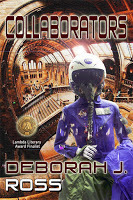 Kimberly Unger, author of Nucleation, has this to say about Collaborators:
Kimberly Unger, author of Nucleation, has this to say about Collaborators:Deborah J. Ross opens Collaborators by flipping the script in a first contact scenario and not stopping there. In her story of a strange new world, the Terrans are the outsiders reaching in and the people of Chacarre and the Erlind are the normal, the everyday folk.
It’s through this flipped lens that the story first opens, a rare look at our version of humanity through the eyes of a different… humanity. Because, as details of this alien world get revealed, it becomes apparent that while some of the structures of Chacarran civilization are strikingly familiar, particularly in politics and protest, there are just as many cultural and biological differences, from gender constructs that transcend the binary on through to clan structures and societal languages hidden in the tremble of fur.
Ross brings us along to follow several life stories as they play out across the backdrop of the politics and perils of diplomacy and, as is almost inevitable when new cultures meet, mistakes are made. Brief windows into the lives and relationships of the Terrans first reveal an earnest attempt to stay neutral and avoid upsetting the balance between two nations in conflict, then a desire to do everything in their power to repair their ship so they can go home. As they overstay their welcome, the Terrans leverage first their influence and then their might. The logic is the same line we have all heard before both in real-life and fiction, to establish a new and stable rule of law so they can get the help they need and leave. The Chacarran and the Erlind start the story on the edge of conflict with each other, but as all the tragedies unfold, the truth of the Terran manipulation comes to light.
With the Terrans and the Chacarran now entangled in a conflict that none wants to continue, but neither can find a way out of, the storylines of our main characters all come together, each contributing their own piece to the final outcome and ultimately finding a way forward that everyone can live with.
This novel is a refresh of a work Ross originally published under the name of Deborah Wheeler, and as such, I feel it may have been a bit ahead of its time. The depth of the world and the complex relations feel much more at home among today's science-fiction trends than in previous decades and as such I am delighted I managed to catch this novel in it;s latest release. Deborah Ross is an expert worldbuilder and the care and attention she pays to developing the specifics of Chacarran culture and the diverse viewpoints of her world helps to put a fresh frame a complex story of first contact, political machinations and a revolution that everybody, even the invaders, wants to see succeed.

December 18, 2020
Book Reviews: Surviving Trauma in a Magical Plague
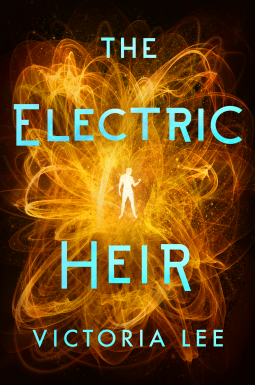
The Electric Heir (Feverwake, Book 2), by Victoria Lee (Skyscape)
This is a sequel to Fever King, which I reviewed here. Although I loved the premise of magic being carried by a highly contagious, near-fatal virus, and the virus having been unleashed on a fractured United States by a single power-mad man, I expressed reservations about the depiction of the moral consequences of actions, specifically politically motivated murder. Yet the world and its principle characters were powerful enough to linger in my memory, so I decided to give this next volume a try. And in it I found everything I missed in the first book. To be sure, this isn’t an easy, light-hearted read. It’s a brutally honest delve into the abuse of power. And as such, I found the story powerful and emotionally fearless. Lee doesn’t shy away from difficult or distressing aspects of the deep trauma suffered by the victims or the pernicious nature of the way their thinking and reactions become warped as the result of repeated abuse. In all the essentials, The Electric Heir completes and redeems The Fever King.
Calix Lehrer rose to power by first creating magically gifted “witchings” (the few survivors of the plague he himself unleashed) and then defending them against neighboring nations. Now over a century old, he chooses apprentices from the elite Level IV school – but these teens are not merely students, they are the targets of his seduction, manipulation, and abuse. In the first volume, refugee Noam is first overwhelmed by the privilege of Level IV, filled with hero worship for Lehrer, and first repelled and then fascinated by his fellow student, the charismatically beautiful telepath, Dara. In the course of that story, Noam falls in love with Dara even as he comes under Lehrer’s influence, to the point of becoming Lehrer’s assassin. It becomes clear that not only is Dara’s sexual relationship with Lehrer non-consensual because of the disparity in age and power and the impossibility of refusal, but it involves repeated brutal physical abuse, masked over by Lehrer’s healing magic. The book closed with Dara’s escape and likely death.
Now Lehrer has lured Noam into Dara’s place, forcing him through psychological manipulation and increasingly violent physical abuse into a model of himself: ruthless, exploitive, and devious. In short, to become Lehrer’s carbon-copy heir. Noam, like Dara before him, craves Lehrer’s approval at first, although it is unclear how much of this stems from Noam’s youthful vulnerability and how much is Lehrer making himself charming and magically persuasive. As it turns out, Dara is not dead, although he no longer possesses magic; he has returned with an underground cabal with one purpose: to end Lehrer and his international reign of terror. Lehrer has planted a spy in their midst, perhaps more than one. Noam, after an uncomfortable, divisive reunion, insists on remaining with Lehrer as part of the plot – even though it puts his sanity and his very life at risk. Meanwhile, Lehrer launches a pre-emptive strike against the neighboring nation of Texas, using weaponized magic. As Noam and Dara separately and together come to terms with both the overt and the subtle effects of abuse, it’s a race against time to stop Lehrer.
It’s a high-wire act to portray slow, intense, personal change and fast-paced action at the same time. Lee deserves immense credit for not abbreviating or minimizing the painful process by which Lehrer’s victims peel back the layers of guilt and shame, discarding the excuses born of what their abuser has led them to believe about themselves. This second volume fully addresses my concerns about the first with courage and compassion. It’s definitely not the place to start the story, but neither is the first book the place to stop. I’m glad I gave The Electric Heir a chance to take me with Noam and Dara in their journey into darkness and the emergence of hope.

December 13, 2020
Winter Newsletter Coming Soon! Free Holiday Gifts and More
 I'll be sending out my winter newsletter soon. Besides the usual greetings I'll be offering a potpourri of free (or low price) books, hand knitted caps, and more for subscribers only.
I'll be sending out my winter newsletter soon. Besides the usual greetings I'll be offering a potpourri of free (or low price) books, hand knitted caps, and more for subscribers only. Don't miss out on the goodies. Subscribe now!
Or, if you'd like a preview: https://preview.tinyurl.com/yydem5yw

December 12, 2020
Do Not Murder In My Name: The Rush to Federal Executions

Now, in the waning days of 2020, the criminal in the White House has pushed through a string of murders. I realize I have used inflammatory language, but nothing less conveys the intensity of my outrage and revulsion. Simply put, someone who initiates and demands the ending of a human life is a criminal. The deliberate, calculated, cold-blooded taking of a human life is murder.
From the BBC:
As President Donald Trump's days in the White House wane, his administration is racing through a string of federal executions.
Five executions are scheduled before President-elect Joe Biden's 20 January inauguration - breaking with an 130-year-old precedent of pausing executions amid a presidential transition.
And if all five take place, Mr Trump will be the country's most prolific execution president in more than a century, overseeing the executions of 13 death row inmates since July of this year.
The five executions began this week, starting with convicted killer 40-year-old Brandon Bernard who was put to death at a penitentiary in Terre Haute, Indiana. The execution of 56-year-old Alfred Bourgeois will take place on the evening of 11 December.
I am the family member of a murder victim, and I speak from personal experience of the impulse to revenge the taking of my mother's life. I also know that this is a natural expression of grief, and that with healing, it passes. To me it is essential that those left behind be given the support and time to process that loss and to re-engage with their lives. To focus on killing someone else freezes us in retaliation mode.
Over the years, I have spoken out against the death penalty, telling my story to groups as diverse as city councils, law students, death penalty abolition activists, and state legislators. In 2012, I was invited to participate in an international conference put on by Murder Victim Families For Human Rights. Then I met others like me, who had lost a single family member to violence, those whose loved ones had been executed or were on death row, and those who experienced both. Every single person who had experienced both was Black. There is no escaping the racial injustice in the way the death penalty is applied (or the way crimes are investigated and prosecuted). Yet the most moving part of that weekend was listening with an open heart to mothers weeping for their executed sons -- and realizing their grief and loss was no less than mine.
If you, who are reading this, take away nothing else, remember this: every person who is put to death is or has been loved by someone, and is grieved by someone, and missed like an aching hole in the heart by someone.
In 2019, I penned a blog for Death Penalty Focus, called "When we focus on revenge instead of healing, we never heal." You can read it below.
In 1986, my 70-year-old mother was asleep in her own bed when a teenaged neighbor broke into her home, raped her, and then beat her to near death and left her face down in a partially filled bathtub. It was a spectacularly brutal, banner headline crime, called by the District Attorney one of the most heinous in the history of the county.
Even in light of what happened, I am opposed to capital punishment, and I’d like to tell you why. I want to emphasize that I do not speak for anyone else. We all have different experiences, different histories, different internal and external resources. If there is one thing I’d like you to take away from my story, it is that not all the families of murder victims want the perpetrators to be executed.
I believe that capital punishment harms the survivors by interfering with the natural recovery process. In other words, when we focus on revenge instead of healing, we never heal.
A number of years ago, when I was being interviewed about my mother’s death, the interviewer said to me, “You seem like such a sweet person. Most of us just aren’t that spiritual.” What she meant was, “How could you not want revenge?” What I thought was, You have no idea how angry I was and how much I wanted to hurt the man who did this.
The rage I felt and that I’ve heard expressed by other murder survivors is so overwhelming, it’s hard to find words to describe it. You feel as if your skin is going to crack open and out will pour enough molten hatred to incinerate the entire world. For years after my mother’s murder, I obsessed over exactly how I would kill the perpetrator with my bare hands and how much I wanted him to suffer for every moment of terror and pain he’d caused her. The images were so vivid, I couldn’t tell if I was awake or dreaming.
Adrenaline-fueled anger enables us to get through those early days and weeks. It sharpens our senses and focuses our thoughts. Our hearts pump faster. Biologically, we are primed to do whatever is necessary to meet the threat. We don’t feel our own injuries, either of body or of mind or spirit. All our resources are devoted to our immediate survival. In some circumstances, this lasts only a short period of time. I know people who have lost loved ones to murder, but in that same incident, the murderer was also killed. At the other extreme are instances where the perpetrator is never discovered and the survivors must cope with the nightmare of walking down the street, suspecting every passer-by or wondering if the murderer has taken another life. I know people in that situation, too.
Anger and the craving for revenge are normal reactions when someone you love has been viciously attacked, their dignity as well as their lives stripped from them. At the same time, these feelings fuel the illusion that retribution erases pain, and popular media constantly reinforce this illusion.
We human beings aren’t meant to stay in this hyper-alert, super-reactive, primed-for-battle state indefinitely. Mental health suffers as well as physical health. Most of all, we lose our selves. When we re-organize our thoughts and our lives around the goal of retaliation, we have nothing left over for the difficult work of healing. Even the process of grieving becomes distorted. We become focused on one single goal: making the perpetrator suffer.
This is what happens when someone – the District Attorney, for example – says to us when we are at our most vulnerable, when we’re in so much pain we can’t think straight: “When the person who did this is dead, you will have closure. It will all be over. You will feel better and get your life back again.”
Please understand: This is a cruel lie. We can never go back to the way things were before the murder. But the death of another human being cannot ease our agony. All such a promise does is keep us locked — incarcerated — in a permanent state of bitterness and hatred.
So what’s the alternative? On hearing my story, many people ask me, “How did you survive?” But I don’t think survival is the question. Although numb with shock and drenched in grief, we get up in the morning. We brush our teeth. We go back to work. I had two daughters to care for, one almost seven and the other three months old; their needs couldn’t wait. We take on the trappings of an ordinary life, carrying on in the blind faith that our insides will someday match the artificial normality of our outsides. In other words, we do what seems best to us in order to survive.
I was fortunate enough – and desperate enough – to seek out skilled professional care with a therapist experienced in treating PTSD. Because the kid who killed my mother was an alcoholic/addict, I attended Alanon meetings for over 20 years to work on those issues.
We can never go back to who we were before the murder, but we can go forward, re-engaging with positive, meaningful aspects of life, fully experiencing our feelings, and understanding what we have lost and what can never be replaced, but what can be created. By acknowledging and experiencing our painful emotions, we allow fresh air and sunlight into our wounds. That’s how healing takes place. The more we stop looking to an external event — the execution of the murderer — to somehow make us feel better or to “achieve closure,” and instead concentrate on taking care of ourselves — our health, our hearts, our families, our spirits — the better we will fare.
Almost every family member of a murder victim has lost not only a loved one but our belief in the decency of our fellow humans and our sense of safety in the world. Over the years, I found comfort, understanding, and strength in sharing my story with others who have endured similar losses. In listening with an open heart with families of those who have been executed, I recognize their loss because it is the same as my own. I can tell you unequivocally that I never, ever want anyone to suffer as I have. The life of their loved one has been taken not in a moment of anger or passion but with cold, deliberate malice on the part of the government. I refuse to allow my personal tragedy to be used as justification for deliberate, state-sanctioned murder.
“No killing in my name.”

December 11, 2020
Very Short Book Reviews: For Your Winter Reading Delight
A Killing Frost, by Seanan McGuire (DAW)
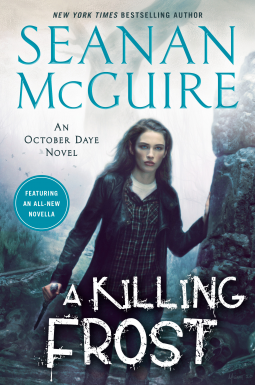
The “October Daye” series keeps getting better! And by “better” I mean richer and more nuanced, always packed with action and dramatic tension and characters we have come to adore. As Toby and Tybalt-King-of-Cats prepare their wedding, she is jolted to discover that she must invite her father to the ceremony or risk the dire consequences of an insult. In this case, her father is not her biological sire but the ex-husband of her mother – the notorious and much-despised Simon Torquill. Simon had made strides toward redemption when he traded his Way Home to save his daughter and is now in the thrall of an evil faery queen. Toby’s quest involves far more than tracking him down. The themes of forgiveness, loyalty, self-discovery, and compassion for self and others run like golden threads through the vivid action.
The Properties of Rooftop Air, by Tim Powers (Subterranean)
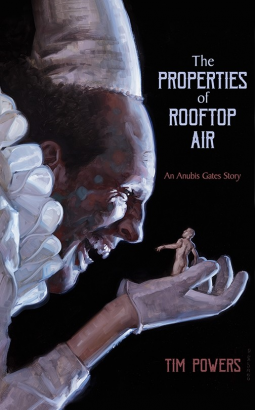
“If Charles Dickens had written Killer Klowns,” by Tim Powers doesn’t come close to the weirdness of this dark – dare I say Dickensian – novella. It’s definitely one of the edgier, darker Powers works I’ve read, and the novella length sharpens the focus further. A must-read for Powers fans and lovers of the darkly twisted, although not for the faint of heart and probably not the best gateway drug. If you’re new to Powers, try The Anubis Gates, On Stranger Tides, or Declare before diving into this one.
Adventures of a Dwergish Girl, by Daniel Pinkwater (Tachyon)
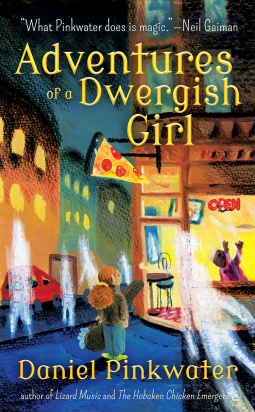
Daniel Pinkwater is at his best, most charming and delightful in this tale of a girl from the Dwerg people – you know, the “little men” responsible for Rip Van Winkle sleeping for twenty years? The ones you can never find, no matter how hard you look? The ones who mine gold in the Catskills, can run unbelievably fast, practice domesticity on a level capable of boring any young person to tears? Such is Molly Van Dwerg’s world until she decides to leave home, armed with a couple of Dwergish gold coins and irrepressible self-confidence. Her gift for making friends is rivaled only by her appetite for pizza and papaya juice. When the nearby town of Kingston is menaced by bad guys after the gold and willing to burn down the town to get it, Molly enlists her friends and her wits to save the day.
Charming reading for the entire family.

December 7, 2020
Guest Blog: Giving Up on a Novel - Yes or No?
Today's guest post comes from Janice Hardy's "Fiction University."
How to Tell if You Should You Give Up On Your Novel and Write Something New By Janice Hardy
By Janice HardyNot all novels need to be written. Is yours one of them?
Right after my third novel was published (2011), I hit a bad patch of writing. My muse went on vacation, every sentence I typed was a battle, and writing became a chore I dreaded. Although it felt like giving up, I shifted my writing focus to nonfiction until telling stories became fun again. Eventually it did, but it took years.
I wrote a lot of so-so novels during that time. Every single one was based on an idea I loved, but they needed a lot of revising and overhauling to make them work, and I wasn’t sure if revising them yet again was a good idea or not.
Idea #1 frustrated me for two and a half years of revisions. Idea #2 took another two years of my life that went nowhere. Idea #3 was a NaNo project that actually made writing fun again, but then languished when I wasn't sure what to do with it next. It was outside my regular genre and market, and trying to sell that one felt like I was starting over again as a writer.
Is it wise to keep struggling with a novel that might never work, or is it better to work on something new?
This is a tough call for any writer. We put so much effort into a manuscript, and it’s hard to let that go. All that work. All that creative energy. Just gone. It’s easy to understand why we hold on tight and refuse to let go, even if deep down, we know we should. The manuscript is drowning, and it’s dragging us under with it.
If you're facing a similar choice, here are some things to consider:
1. How much work does the manuscript really need?
Sometimes the only way to make a novel work is to trash everything but the idea and start fresh. Which means, if it usually takes you two years to write a novel, it'll likely take you that long to to do a full re-write. Don't con yourself about this (it's SO easy to do)...if all the manuscript needed was a few months of tweaks, you probably would have done that already.
Take some time and look at what needs to happen to make the novel work. Really understand what you're getting yourself into by staying with it. Do you really want to put that much more work into this idea? There's no wrong answer here, This is about you.
For example, for my books, Idea #1 needed a different protagonist, a deleted POV character, and a plot revamp. Half the book would have to be rewritten, and the other half revised to make the new parts work. Idea #2 needed a total rewrite from the plot up. The plot direction was what didn't work. Idea #3 just needed the normal amount of revising.
(Here’s more on 3 Ways to Tell if a Manuscript Is Worth Going Back to)
2. What are the odds that working on this manuscript will trigger the same frustrations as before?
Be honest. If you're breaking out in a cold sweat just thinking about it, that's a pretty good indication you should move on to something new. But if there's a glimmer of excitement at finally getting this project to work, maybe it's worth giving it another shot.
How do you feel about the novel? What emotions does it trigger in you? Is it keeping you from writing?
For me, Idea #1 carried a very real risk of plunging me back into darkness. There was just so much baggage associated with it, and even though I loved the idea, and I thought I could rework it in six months, I'd thought that before. Idea #2 didn't have that same risk. I could start over there and be okay. It wasn't the book that made me dread writing, so it didn't have the same emotional triggers. Idea #3 was fun to write, and probably fun to revise.
(Here’s more on The Circle of Write (Or Why Some Books Kick Our Butts)
3. Is there a new project that's more exciting?
If a new idea is calling to you, and you spend more time thinking about it than the book that's giving you trouble, that could be your subconscious telling you it's time to set that project aside. If your creativity has dried up for one book, exploring another could be the way to rekindle the muse.
Of course, be wary if you repeatedly hit a wall with one idea and start over with a new one—that could indicate the problem is the writer, not the book.
For me, all three ideas sat behind a new idea (or two, maybe three) I was eager to write.
(Here’s more on Heads or Tails? Choosing What Story Idea to Work on Next)
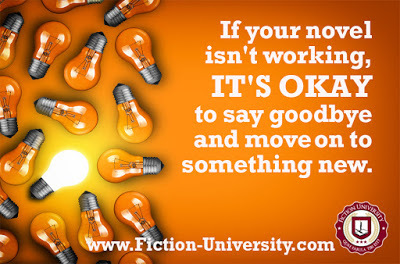
4. Why does it have to be this novel?
If an idea keeps drawing you back, there's a reason. What about this project makes you want to write it, even though it's frustrating you and feels like it's never going to work? Why do you love it? What do you need to do to write it?
For me, Idea #1 was the first idea I got excited about after I'd sold my trilogy (and my new editor loved the concept), so I felt like I owed it to myself to write it. I loved the setting, the themes, the characters. Idea #2 explored an idea and world I found fascinating, with characters I really wanted to get to know better. Idea #3 had an idea that tickled me to no end, and allowed me to try something new.
(Here's more on 5 Reasons to Give Up on Your Novel (And One Reason Not to))
Now ask yourself, "Do I really want to finish this novel?"
This is a hard question to ask, because often we've put so much work into a novel that setting it aside feels like we failed.
But not every story works and not every idea needs to be written. If an idea isn't ready, or never will be ready, that doesn't mean we're bad writers.
If the answer is yes: Finish that novel. Figure out what you need to do to make it work, and go after it. Don't be afraid to make deep cuts, change characters, re-do the plot, or even start fresh with nothing but the idea. The idea is what keeps drawing you back, so that's all that really matters. Everything else can be changed to best fit that idea (even if that idea is a character you can’t let go of).
If the answer is no: Bid that project farewell and move on to a new idea. Don't feel guilty about all the work you put into it, or think you have to finish every manuscript you start. It was a good learning experience, and no writing is ever wasted. What you did with that manuscript will make the next one that much easier to write, and you'll be a whole lot happier.
(Here’s more on Getting Your Novel to the Finish Line: Resisting the Shiny New Idea (Part Three))
What I decided from this exercise:
Idea #1 was a hesitant no with a side of maybe. I thought I could fix it one day, maybe in a year or two, after I'd had a good run of writing and I was no longer worried about losing my muse again. If I went back to it, I'd likely spend the next year struggling with it and feeling miserable.
I did go back to this manuscript and start over a few years ago. I gave it six months, wrote a very rough draft—and it still didn’t work. -sigh- Some books are just like that. And one day, I’m going to try again. This is an idea I just can not give up on no matter how many times it’s knocked me to the mat.
Idea #2 was a solid yes, but after I wrote the projects I was more excited about. I thought it would be a good book to return to later, maybe a NaNo novel—knock out the first draft for fun and see what happened. If it worked, I'd revise, but if not, I'd move on.
Idea #3 was the strongest and had the most promise, and more importantly—it was fun to work on. I finished this novel and indie published it since it was outside my normal market. It's the first book in my Grace Harper urban fantasy series, Blood Ties.
The sheer time, energy, and dedication it takes to write a novel means it's hard to walk away from it when we need to.
Like a bad relationship, it's easier to stay one more day with what's known than to quit and venture into the unknown. But if a fresh start is the right thing to do, we need to be able to look at our writing objectively and judge the best course for our career and our sanity.
If your novel isn't working, it's okay to say goodbye and move on to something new. Just as it's okay to stay with a novel you love if you honestly think you can make it work.
Trust your instincts, consider all your options, and do what's best for you as a writer.
EXERCISE FOR YOU: Take a few days and analyze your manuscript. Answer the above questions and decide if this is a manuscript you want to stick with, or let go. Be honest with what you need as a writer at this time.
Are you wondering if you should give up on a novel? What's stopping you?
Need help revising? Get all three Fixing Your Revision Problems books in one omnibus!
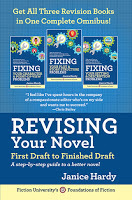 This book contains Fixing Your Character & Point-of-View Problems, Fixing Your Plot & Story Structure Problems, and Fixing Your Setting & Description Problems--PLUS a BONUS workshop: How to Salvage Half-Finished Manuscripts.
This book contains Fixing Your Character & Point-of-View Problems, Fixing Your Plot & Story Structure Problems, and Fixing Your Setting & Description Problems--PLUS a BONUS workshop: How to Salvage Half-Finished Manuscripts. A strong story has many parts, and when one breaks down, the whole book can fail. Make sure your story is the best it can be to keep your readers hooked.
With clear and easy-to-understand examples, Revising Your Novel: First Draft to Finished Draft Omnibus offers eleven self-guided workshops that target the common issues that make readers stop reading. It will help you:
Flesh out weak characters and build strong character arcsFind the right amount of backstory to enhance, not bog down, your storyCreate unpredictable plots that keep readers guessingDevelop compelling hooks to build tension in every sceneDetermine the right way to include information without infodumpingFix awkward stage direction and unclear character actions Revising Your Novel: First Draft to Finished Draft Omnibus starts every workshop with an analysis and offers multiple revision options in each area. You choose the options that best fit your writing process. This easy-to-follow guide will help you revise your manuscript and craft a strong finished draft that will keep readers hooked.
Available in paperback and ebook formats.
 Janice Hardy is the award-winning author of the teen fantasy trilogy The Healing Wars, including The Shifter, Blue Fire, and Darkfall from Balzer+Bray/Harper Collins. The Shifter, was chosen for the 2014 list of "Ten Books All Young Georgians Should Read" from the Georgia Center for the Book.
Janice Hardy is the award-winning author of the teen fantasy trilogy The Healing Wars, including The Shifter, Blue Fire, and Darkfall from Balzer+Bray/Harper Collins. The Shifter, was chosen for the 2014 list of "Ten Books All Young Georgians Should Read" from the Georgia Center for the Book. She also writes the Grace Harper urban fantasy series for adults under the name, J.T. Hardy.
When she's not writing novels, she's teaching other writers how to improve their craft. She's the founder of Fiction University and has written multiple books on writing.Website | Facebook | Twitter | Pinterest | Goodreads | Amazon | Barnes & Noble | iTunes | Indie Bound

December 4, 2020
Short Book Reviews: Florence of the Eternal Renaissance
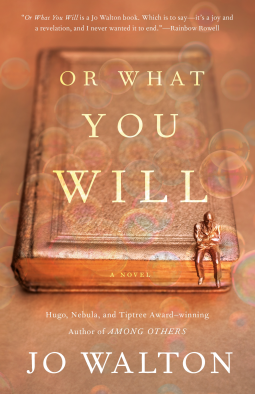
Or What You Will, by Jo Walton (Tor Books)
Imagine a world that unites Shakespeare’s two plays, As You Like It and Twelfth Night. Imagine that world as a fantasy series by a contemporary author, determined to finish the series before she dies of cancer. Imagine the narrator being her muse, the solace of her wretched childhood, now determined to save her life by transforming her into a character in her own world, where death comes about only by an act of will. That’s a very rough description of this ground-breaking novel, liberally sprinkled with fascinating forays into the Renaissance – its artists, architects, and thinkers. Illyria, the creation of the author, Sylvia, is an idealized Renaissance Florence frozen in time, set apart from “Progress.”
Effortless prose, nuanced layering of past, present, and the world of the imagination, add up to a rich and complex reading experience. If only Sylvia’s “Illyria” books were real, we’d all get to run away there.

November 27, 2020
Short Book Reviews: The Collapse of All Worlds
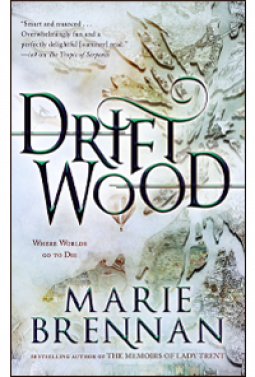
Driftwood, by Marie Brennan (Tachyon)
Consider a universe in which dying worlds slowly accrete together, colliding and compressing into a super-condensed Core. The aggregate is known as Driftwood, with the outer rings being less reduced in size, the inner ones mere fractions of their former selves. Each world operates according to its own rules; some have magic, others don’t; some have more than one sun, and so forth. No matter what the geography or culture, one constant remains: the desperate need to preserve memory and identity against the final, irreversible collapse.
This present volume comprises short fiction, some previously published, others original, loosely framed but eminently readable as stand-alone pieces. Overlapping worlds, occasional familiar place names, a historical timeline, and a charismatic recurring character enhance the cohesiveness of the collection. For me, though, the unifying factor was the shared experience, across cultures and personalities, of inevitable loss through change.
In “The Second Coming,” Yeats wrote, “Things fall apart; the centre cannot hold.” But in the world of Driftwood, things fall into a center from which nothing emerges, not even the memory of what was once vital and precious. Yet despite the sadness, in the skillful storyteller hands of Marie Brennan, the stories move through compassion to hope, with many memorable moments along the way.

November 21, 2020
Jaydium Chapter 6 Now on Curious Fictions
The next chapter of Jaydium is available FREE on Curious Fictions!
Jaydium, Chapter 6By Deborah J. Ross
Apr 6, 2020 · 1,707 words · 7 minutes

Art by Vincent Di Fate. Edit Art · Remove Art
From the author: Far in the future, an interplanetary civil conflict has ground to an uneasy halt. Kithri, abandoned on a desolate mining planet, meets Eril, shell-shocked pilot. A freak accident sends them back to a time when their desert world was lush and green, when an alien civilization stands on the brink of a war of total destruction. They must choose to remain outside the conflict or to stand up for what they believe.
An audio version is available for this chapter. Listen online →
JAYDIUM
Chapter 6
"What's happened?" Kithri gasped. "Where the bloody hell are we?"
Eril didn't answer. For the moment, he had no ready answers. Adrenalin thrilled through his veins, bringing his vision into sharp focus--every instrument on the scrubjet's panel, every tone of green filling the endless Plain, every brilliant mote of sunlight.
Silently they circled back and brought Brushwacker to a halt on the wide, wind-scoured ledge. In contrast to the debris-strewn entrance they'd flown into, here they found ample room here to land. Otherwise, the treeless purple-gray mountainside looked just like the one they'd left, but that was the only familiar feature of the landscape.
Kithri yanked the door open and jumped out, Eril at her heels. "The Plain, the dust--it's gone, all gone!" she cried. "Where--oh god, where did all those trees come from? Even the sky looks different, it's..." Her voice trailed off into a whisper. "It's so beautiful..."
Eril had to agree with her. Standing there open-mouthed and momentarily speechless, he could see for hundreds of miles, clear to where the dazzling azure sky melted with the forest in a thin, hazy line. From this height, the expanse of green resembled a felt-topped gaming board. He'd seen forests before, on Terillium where he was born and the two worlds where he saw ground action, but compared to this one they were nothing but pale, manicured gardens. He imagined tigers prowling the depths, hunted by spear-wielding woodmen who guarded the ruins of once fabulous cities, the last remains of a race of galaxy-spanning telepathic tyrants...
Argh! I must have seen too many bad tri-vids as a kid. But his nerves hummed with a

November 20, 2020
Short Book Reviews: The Murderbot Novel, Hooray!
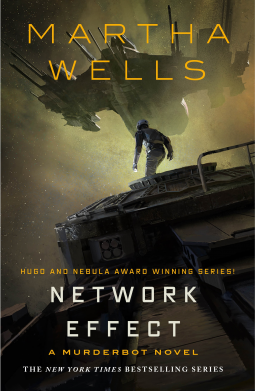 Network Effect, A Murderbot Novel, by Martha Wells (Tor.com)
Network Effect, A Murderbot Novel, by Martha Wells (Tor.com) Murderbot, beloved and intrepid SecUnit-with-a-soul, graced previous novellas (All Systems Red -- 2018 Hugo Award for Best Novella, Nebula Award for Best Novella, Locus Award, and New York Times and USA Today Bestseller -- Artificial Condition, Rogue Protocol, and Exit Strategy). Once an android Security Unit capable of ruthless and lethal efficiency but lacking volition, this particular unit managed to free themself from its governor module. Over the course of the earlier adventures, they gave themself a personal name (Murderbot) and developed relationships with humans and artificial intelligences alike, often filling empty time and educating themself about human behavior by watching space-based soap operas. One such AI from a previous novella was the snarky ship brain Perihelion, nicknamed ART. Now Murderbot has their own novel, with plenty of scope for reflection, development, and Things Going Seriously Splody. This current volume reunites Murderbot with their favorite and not-so-favorite humans, with ART, and with yet more seasons of ridiculously unrealistic serial dramas, all tied up with a burgeoning conflict between the exploitive Corporate Rim and pockets of egalitarian resistance.
As complete in itself and entertaining as Network Effectis, I highly recommend reading the previous works first. Themes run like seams of gold from one story to the next as Murderbot develops self-awareness, compassion, friendships, and purpose. This doesn’t happen instantly or easily. Growing up is hard, and even harder when one is a newly empowered consciousness in an organo-mechanical body capable of mass murder at a moment’s notice.
The struggle from being a mere tool to becoming a person often takes unexpected, poignant turns. I found some of the most touching moments to be when Murderbot realizes with confusion that while a few humans treat them as a person, the majority of others don’t, and Murderbot’s nurturing mentorship of another SecUnit. It’s said that the best way to solidify growth is to guide another, and this is true here. By giving SecUnit 3 the key to disabling its own governing module and then asking, “What do you want?” Murderbot may be igniting a robotic revolution. We’ll see where the next installment leads.
Needless to say, Network Effect grabbed me on the first page and held my rapt attention through plot twists, heart-pounding perils, and tender moments. The entire series is highly recommended.




